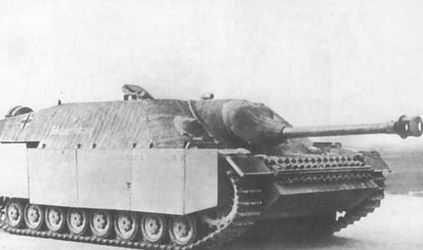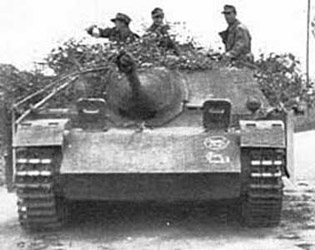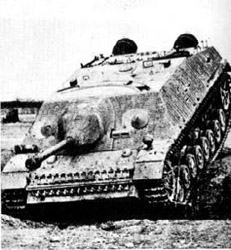/Vehicles/Axis/Germany/04-Panzerjaegers/Jagdpanzer4/File/Jagdpanzer4.htm | Last Up-date:
Jagdpanzer IV (Tank Destroyer)
Jagdpanzer IV (L/48)
Le Jagdpanzer IV fut étudié à l'origine pour remplacer le Stug III. En décembre 1942, un nouveau chasseur de char disposant d'un blindage frontal de 100 mm, armé du 75 mm Pak 42 L/70 (basé sur le canon du Panther) et basé sur PzKpfw IV fut demandé par le Waffenamt. Une basse silhouette et une superstructure au parois inclinées étaient exigées pour cet engin baptisé dans un premier temps StuG auf Fahrgestell PzKpfw IV (Sd.Kfz.162) mit 7.5 cm PaK L/48 ou encore Jagdpanzer E. Il sera finalement désigné comme Jagdpanzer IV. Sa conception eut lieu début 1943 et le 13 mai Vomag (Maschinenfabrik produisit une maquette en bois, qui fut présentée à Hitler en septembre 1943. Le premier prototype en acier mou fut prêt en octobre 1943. En décembre, le prototype final du Jagdpanzer IV fut enfin prêt et il fut demandé à Vomag de commencer la production aussitôt que possible. Les premiers véhicules de pré-production disposait d'une superstructure avec les coins avants arrondis (coins incurvés) et étaient armés du canon de 75 mm Pak 39 sans frein de bouche. Le premier véhicule de production fut réalisé en janvier de 1944, sur châssis modifié de PzKpfw IV Ausf.F sous la désignation de (leichter) Jagdpanzer IV Ausf.F (Sd.Kfz.162). Il était armé du 75 mm Pak 39 L/48 (avec frein de bouche à double déflecteur ) et de deux mitrailleuses MG42 de 7.92 mm Comme le L/48 était aisément disponible au contraire du L/70 ce fut le premier qui sera monté sur le Jagdpanzer IV.
Jagdpanzer IV was studied in the beginning to replace Stug III. In December 1942, a new hunter of tank having a frontal shielding of 100 mm, armed with the 75 mm Pak 42 L/70 (based on the gun of the Panther) and was based on PzKpfw IV was required by Waffenamt. A low silhouette and a superstructure with tilted walls were required for this machine initially baptized StuG auf Fahrgestell PzKpfw IV (Sd.Kfz.162) mit 7.5 cm PaK L/48 or Jagdpanzer E. It will be finally indicated as Jagdpanzer IV Its design took place at the beginning of 1943 and on May 13 Vomag (Maschinenfabrik produced a model out of wooden, which was presented to Hitler in September 1943. The first soft steel prototype was ready in October 1943. In December, the final prototype of Jagdpanzer IV was finally ready and it was requested from Vomag to begin the production as soon as possible. The first vehicles of pre-production had a superstructure withround front corners (curved corners) and were armed with the 75 mm Pak 39 gun without muzzle brake. The first vehicle of production was produced in January of 1944, on modified chassis of PzKpfw IV Ausf.F under the designation of (leichter) Jagdpanzer IV Ausf.F (Sd.Kfz.162). It was armed with the 75 mm Pak 39 L/48 (with muzzle brake with double deflector) and with two machine-guns MG42 of 7.92 mm. As L/48 was easily available on the contrary of L/70 it was the first which will be assembled on Jagdpanzer IV.
 |
Jagdpanzer IV |
Le bas de caisse du Panzer IV avait été maintenu, seul l'avant avait été modifié par l'adoption de parois obliques formant un nez très pointu. Le blindage de la partie supérieure du nez était de 60 mm alors que celui de la partie inférieure était de 50 mm. A l'intérieur les réservoirs de carburant, les coffres de munitions furent changés de place, la trappe de secours du plancher et le moteur de rotation de la tourelle furent supprimés. De plus un nouveau système de chauffage et de ventilation fut installé. La superstructure s'est composée des parois inclinées. Toutes les parois de la superstructure étaient composées de grandes tôles de blindage s'emboîtant et soudées entre elles, ce qui facilitait le processus de fabrication. Les blindage latéral de la superstructure était épais de 30 mm et le frontal de 60 mm. Les parois inclinées procuraient une bonne protection (proportionnée) aux quatre membres de l'équipage: le commandant, le tireur, le chargeur et le pilote. De plus sa basse silhouette (1.85m) en faisait une cible bien difficileà atteindre. Beaucoup d'exemplaires furent munis de Schürzen et recouverts de pâte Zimmerit et celadès l'usine (jusqu'en septembre 1944).
The lower hull of Panzer IV had been maintained, only front had been modified by the adoption of oblique walls forming a very pointed nose. The shielding of the higher part of the nose was 60 mm whereas that of the lower part was of 50 mm. A the interior the fuel tanks, the boxes of ammunition were changed place, the hatch of help of the floor and the engine of rotation of the turret was removed. Moreover one new system of heating and ventilation was installed. The superstructure was composed of tilted walls. All the walls of the superstructure were made up of large armour plates being encased and welded between them, which facilitated the manufacturing process. The side shielding of the superstructure was thick 30 mm and the frontal of 60 mm. The tilted walls got a good protection (proportioned) to the four members of the crew: the commander, the gunner, the loader and the pilot. Moreover its low silhouette (1.85m) made of it a not easy target. Many specimens were provided with Schürzen and covered with Zimmerit paste from the factory (until September 1944).
75
mm Pak 39 L/48 Penetration of a shielding plate (mm) under a plunging angle of 30° |
|||||||
Ammo |
Weight |
Velocity |
100
m |
500 m |
1000
m |
1500 m |
2000
m |
| PzGr 39 | 6.8 kg |
790 m/s |
106 |
96 |
85 |
74 |
64 |
PzGr 40 |
4.1 kg |
990 m/s |
143 |
120 |
97 |
77 |
_ |
Le canon anti-char de 75 mm court (L/48) était monté (sur un masque épais de 80 mm) dans la plaque frontale, flanqué de deux sabords de mitrailleuse (avec couvertures coniques) et d'un viseur de pilote. Le canon était monté avec un décalage 20 cm sur la droite et disposait d'une traverse limitée à 12° à gauche comme à droite. Le champ de tir vertical variait entre -8 et +15°. Un total de 79 coups de 75 étaient stockés à l'intérieur avec 1200 coups de 7.92 mm pour les mitrailleuses. Le L/48 utilisait un frein de bouche à double déflecteur.
Sur route le Jagdpanzer IV pouvait atteindre les 40 km/h malgré son poids de 24.5 tonnes. Comme pour le Panzer IV le moteur était le Maybach HL 120 TRM. Un total de 769 exemplaires sera produit de janvier 1944 à novembre 1944. Une version de commandement fut créée, équipée d'équipements radio supplémentaire et d'un cinquième homme d'équipage faisant office d'opérateur radio. En septembre 1944, un Jagdpanzer expérimental (neuer Art Starr) armé d'un 75 mm Pak 39 L/48 fixe fut réalisé à deux exemplaires. Rencontrant trop de problème ce modèle fut abandonné au profit du Jagdpanzer 38(t) Hetzer.
The short 75 mm anti-tank gun (L/48) was assembled (on a mantlet thick of 80 mm) in the frontal plate, flanked of two ports of machine-gun (with conical covers) and a visor of pilot. The gun was assembled with a shift of 20 cm on the right and had a traverse limited to 12° on the left like on the right. The vertical field of fire varied between -8 and +15°. A total of 79 rounds of 75 were stored inside with 1200 rounds of 7.92 mm for the machine-guns. L/48 applied a muzzle brake with double deflector.
On road Jagdpanzer IV could reach the 40 km/h in spite of its weight of 24.5 tons. As for Panzer IV the engine was the Maybach HL 120 TRM. A total of 769 specimens will be produced from January 1944 to November 1944. A version of command was created, equipped withadditional radio equipment and a fifth crewman acting as radio operator. In September 1944, experimental Jagdpanzer (neuer Art Starr) armed with one rigid 75 mm Pak 39 L/48 was realized at two specimens. Meeting too much problem this model was abandoned to the profit of Jagdpanzer 38(t) Hetzer.
 |
 |
Jagdpanzer
IV |
|
src: Site Panzer
Page von Reitsch |
src: Site "Juggernauts
of the second world war" |
Le Jagdpanzer IV fut versé dans les Panzerjäger Abteilungen des Panzerdivisions et des Panzer Grenadier Divisions à partir de mars 1944. Il connu le combat au sein de la Division Hermann Goering en Italie, puis avec la 4e et 5e Panzerdivision sur le front est. En juin 1944, seulement 62 Jagdpanzer IV étaient encore service avec Panzer Lehr, la 9e Panzer et la 12e SS-Panzer "Hitlerjugend" (qui en reçu 10 à la mi 1944) en Normandie. Le Jagdpanzer IV fut surtout employé pour un appui feu aux groupes d'infanterie et pour la défense antichar.
Jagdpanzer IV was versed in Panzerjäger Abteilungen of Panzerdivisions and Panzer Grenadier Divisions as from March 1944. It known the combat within Division Hermann Goering in Italy, then with 4th and 5th Panzerdivisions on the Eastern front. In June 1944, only 62 Jagdpanzer IV were still service with Panzer Lehr, 9th Panzer and 12th SS-Panzer "Hitlerjugend" (which in receipt 10 at mid the 1944) in Normandy. Jagdpanzer IV was especially employed like support vehicle with the groups of infantry and like tank destroyer.
Data |
Drawings |
Sources:
- Pz.Kpfw IV in action, Armor Number 12 (squadron/signal publications, inc.)
- Connaissance de l'Histoire (Hachette) - N°17 - " Les chars de combat allemands 39-45"
- Connaissance de l'Histoire (Hachette) - N°5 - " Véhicules blindés allemands 39-45"
- Les Blindés de la Seconde Guerre Mondiale (Atlas)
- Sturmartillerie & Panzerjäger 1939-1945 (Osprey Military) - New Vanguard N°34
- Site "Achtung Panzer" - http://www.achtungpanzer.com
- Site "WWII Vehicles" - http://www.wwiivehicles.com/germany/tank-hunters/jagdpanzer-iv.asp
- Site "Second World War Armour" - http://www.onwar.com/tanks/index.htm
